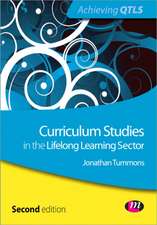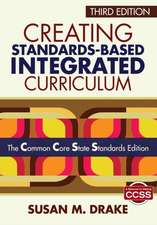Using the Parallel Curriculum Model in Urban Settings, Grades K-8
Editat de Sandra N. Kaplan, Irene Guzman, Carol Ann Tomlinsonen Limba Engleză Paperback – 2 noi 2009
Preț: 332.45 lei
Nou
Puncte Express: 499
Preț estimativ în valută:
63.63€ • 66.25$ • 53.77£
63.63€ • 66.25$ • 53.77£
Carte tipărită la comandă
Livrare economică 10-24 martie
Preluare comenzi: 021 569.72.76
Specificații
ISBN-13: 9781412972192
ISBN-10: 1412972191
Pagini: 128
Dimensiuni: 216 x 279 x 13 mm
Greutate: 0.36 kg
Ediția:New.
Editura: SAGE Publications
Colecția Corwin
Locul publicării:Thousand Oaks, United States
ISBN-10: 1412972191
Pagini: 128
Dimensiuni: 216 x 279 x 13 mm
Greutate: 0.36 kg
Ediția:New.
Editura: SAGE Publications
Colecția Corwin
Locul publicării:Thousand Oaks, United States
Recenzii
“My experience teaching the lessons to students helped me understand the importance of self-reflection. The students were able to reflect on their own abilities in learning. The opportunity to define themselves as learners is informative and empowering.”
"Teaching students how to be 'lifelong learners' can be realized by helping them develop a sense of responsibility for their learning. These lessons provide that opportunity for students."
"Teaching students how to be 'lifelong learners' can be realized by helping them develop a sense of responsibility for their learning. These lessons provide that opportunity for students."
Cuprins
Preface: Bridging the Gap
Acknowledgments
About the Authors
Introduction: The Purposes of the Parallel Curriculum Model
Multiple Applications and the Parallel Curriculum Model
Flexibility of the Parallel Curriculum Model
Structure of the Parallel Curriculum Model
Responding to Student Diversity With Curriculum Diversity
Urban Classroom Dynamics
Developing an Academic Skill Set
Introduction to the PCM Focus Lessons
Lesson Plan Format
Implementing the Lesson Plan
Lesson Plan Scheduling
Depth and Complexity
1. Scholarly Dispositions
Lesson A: Developing an Interest (I)
Lesson B: Developing an Interest (II)
Lesson C: Developing Tenacity
Lesson D: Determining Relevance
Lesson E: Confronting Failure
Lesson F: Intellectual Strengths
Lesson G: Receptivity to Experience
2. Participation Skills
Lesson A: Questioning
Lesson B: Asking for Clarification
Lesson C: Restating
Lesson D: Acknowledging Peers
3. Self-Advocacy
Lesson A: Establishing a Voice
Lesson B: Building Confidence
Lesson C: Establishing an Identity
Lesson D: Multiple Group Membership
4. Presentation Skills
Lesson A: Talking Steps
Lesson B: Ways to Say It
Lesson C: Engaging the Audience
Lesson D: Staying on Target
Appendix A: Designing Curriculum Using the Parallel Curriculum Model
Appendix B: Teaching the Prompts of Depth and Complexity
References
Index
Acknowledgments
About the Authors
Introduction: The Purposes of the Parallel Curriculum Model
Multiple Applications and the Parallel Curriculum Model
Flexibility of the Parallel Curriculum Model
Structure of the Parallel Curriculum Model
Responding to Student Diversity With Curriculum Diversity
Urban Classroom Dynamics
Developing an Academic Skill Set
Introduction to the PCM Focus Lessons
Lesson Plan Format
Implementing the Lesson Plan
Lesson Plan Scheduling
Depth and Complexity
1. Scholarly Dispositions
Lesson A: Developing an Interest (I)
Lesson B: Developing an Interest (II)
Lesson C: Developing Tenacity
Lesson D: Determining Relevance
Lesson E: Confronting Failure
Lesson F: Intellectual Strengths
Lesson G: Receptivity to Experience
2. Participation Skills
Lesson A: Questioning
Lesson B: Asking for Clarification
Lesson C: Restating
Lesson D: Acknowledging Peers
3. Self-Advocacy
Lesson A: Establishing a Voice
Lesson B: Building Confidence
Lesson C: Establishing an Identity
Lesson D: Multiple Group Membership
4. Presentation Skills
Lesson A: Talking Steps
Lesson B: Ways to Say It
Lesson C: Engaging the Audience
Lesson D: Staying on Target
Appendix A: Designing Curriculum Using the Parallel Curriculum Model
Appendix B: Teaching the Prompts of Depth and Complexity
References
Index
Descriere
Featuring 16 field-tested lesson plans, this book presents a high-quality curriculum that helps urban youth develop key learning skills such as resiliency, self-motivation, and collaboration.
















